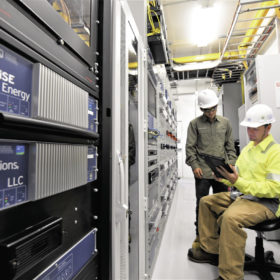
As higher concentrations of renewable energy and storage capacity come online, the control systems of today cannot solve the problem of a two-way predictable grid of the future. Enter Pxise Energy Solutions (pronounced “Pice”). Using real-time data and algorithms to make intelligent decisions, the company’s software technology is breaking down barriers for grids to operate with high levels of renewable penetration. Pxise says its software can unleash the benefits that batteries are able to provide.
From Energy Storage North America special edition
The power plant of today is primarily based on data that feed into it – using what is called the SCADA (Supervisory Control and Data Acquisition) system. Operators are served with data every few seconds, which is refreshed on the screen, and a human has to take action in order to control the power system. And this is how power systems are still being controlled around the world. But energy intelligence tech company Pxise has a new system software operating solution.
“In order to transition to a more automated system, you have to build in intelligence to gain information,” says Patrick Lee, president and co-founder of Pxise, an offshoot of Sempra Energy. “And you also have to build it on a technology to address scalability and flexibility.”
Attend Energy Storage North America
Join pv magazine at the Energy Storage North America conference and exhibition in sunny San Diego, California. Receive a 10% discount on your attendance by entering the code ‘PVMAG10’ when you register. Be sure to join us for our ‘Adding Value to Solar Projects with Storage’ session of the conference on Thursday, November 7, 2019 at 10:45 a.m
Lee explains that Pxise’s software operates in a manner similar to running an airplane on autopilot – it takes in information, makes decisions, and then controls what happens, with or without the intervention of people. Developed in partnership with the software developer OSIsoft, the Windows-based system provides high-speed data and insights with intelligent algorithms to control the systems for utility-scale renewables, microgrids and islands, and electric utilities.
Pxise uses a time-synchronized technology called phasor measurement units (PMUs), originally developed by Virginia Tech in 1988 for system coordination and then later adapted for transmission networks for blackout control. “We further expanded the application of that technology into streaming control,” says Lee. Pxise secured a number of patents to use PMU technology to control the power grid.
The resulting grid control product uses data management tools with time-synchronized sensors to provide just-in-time controls across the entire system – from behind the meter all the way up to the utility. “This is the only way you can manage dynamic, unpredictable resources and flow grid,” says Lee, explaining that the intermittency of solar, wind, and other resources providing power to the grid is a challenge taking place around the world. “System-level thinking is the only way you can manage dynamic, unpredictable resources and flow grid.”
And this could enable greater opportunities and benefits for battery storage systems. Lee explains that batteries today are being used for peak demand shaving, peak shifting, and frequency regulation of the grid – all of which just control one parameter of the battery: real power. “Pxise can control all parameters of the battery from different perspectives,” he says. “We can control real power and reactive power simultaneously.”
Today, many battery systems respond from one to 10 seconds when you command it to move, which Lee says is fairly slow and creates limitations for the battery to realize its full benefits. “Pxise enables the battery to be controlled 60 times per second, or even faster if we wanted to. Being able to control the battery fast or slow enables achievement of the value stack of the battery.”’
While other distributed energy resource management system (DERMS) technologies being deployed are typically engaging and controlling one asset or battery at a time, Pxise’s software is able to control multiple resources, coordinated at the same time. By doing so, the technology unifies control of a hybridized energy system. The operating system remains the same regardless of the energy mix – and the software simply reconfigures to provide flexibility and scalability.
“Utilities are beginning to worry about capacity and asking how much solar and wind they can actually integrate within their systems. Using our technology, unifying control, you can increase hosting capacity of renewable energy,” says Lee. “Pxise removes the technology roadblock to mitigate intermittency and enables reliable, scalable, and safe grid control integrating high levels of renewables.”
Lắp đặt điện mặt trời Khải Minh Tech
https://ift.tt/2X7bF6x
0906633505
info.khaiminhtech@gmail.com
80/39 Trần Quang Diệu, Phường 14, Quận 3
Lắp đặt điện mặt trời Khải Minh Tech
https://ift.tt/2ZH4TRU
Không có nhận xét nào:
Đăng nhận xét